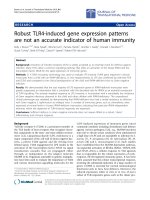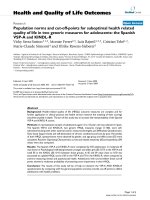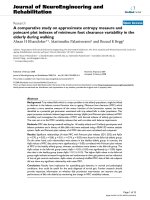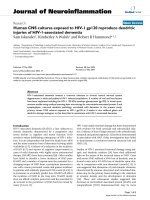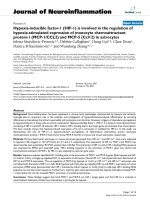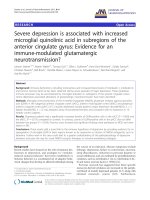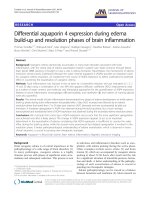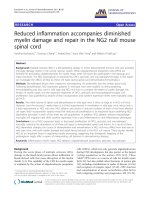báo cáo hóa học:" Airborne particulate matter PM2.5 from Mexico City affects the generation of reactive oxygen species by blood neutrophils from asthmatics: an in vitro approach" docx
Bạn đang xem bản rút gọn của tài liệu. Xem và tải ngay bản đầy đủ của tài liệu tại đây (1.17 MB, 11 trang )
BioMed Central
Page 1 of 11
(page number not for citation purposes)
Journal of Occupational Medicine
and Toxicology
Open Access
Research
Airborne particulate matter PM
2.5
from Mexico City affects the
generation of reactive oxygen species by blood neutrophils from
asthmatics: an in vitro approach
Martha Patricia Sierra-Vargas
†1
, Alberto Martin Guzman-Grenfell
†1
,
Salvador Blanco-Jimenez
†2
, Jose David Sepulveda-Sanchez
†3
,
Rosa Maria Bernabe-Cabanillas
†2
, Beatriz Cardenas-Gonzalez
†2
,
Guillermo Ceballos
†4
and Juan Jose Hicks*
1
Address:
1
Departamento de Investigacion en Bioquimica y Medicina Ambiental, Instituto Nacional de Enfermedades Respiratorias, Ismael Cosio
Villegas, Secretaria de Salud, Mexico,
2
Direccion de Investigacion Experimental en Contaminacion Atmosferica, Centro Nacional de Investigacion
y Capacitacion Ambiental, Instituto Nacional de Ecologia, Mexico,
3
Universidad Autonoma Metropolitana, Unidad Iztapalapa, 09340, Mexico and
4
Laboratorio Interdisciplinario Seccion de Postgrado e Investigacion, Escuela Superior de Medicina, Instituto Politecnico Nacional, DF, Mexico
Email: Martha Patricia Sierra-Vargas - ; Alberto Martin Guzman-Grenfell - ; Salvador Blanco-
Jimenez - ; Jose David Sepulveda-Sanchez - ; Rosa Maria Bernabe-Cabanillas - ;
Beatriz Cardenas-Gonzalez - ; Guillermo Ceballos - ; Juan Jose Hicks* -
* Corresponding author †Equal contributors
Abstract
Background: The Mexico City Metropolitan Area is densely populated, and toxic air pollutants are generated
and concentrated at a higher rate because of its geographic characteristics. It is well known that exposure to
particulate matter, especially to fine and ultra-fine particles, enhances the risk of cardio-respiratory diseases,
especially in populations susceptible to oxidative stress. The aim of this study was to evaluate the effect of fine
particles on the respiratory burst of circulating neutrophils from asthmatic patients living in Mexico City.
Methods: In total, 6 subjects diagnosed with mild asthma and 11 healthy volunteers were asked to participate.
Neutrophils were isolated from peripheral venous blood and incubated with fine particles, and the generation of
reactive oxygen species was recorded by chemiluminescence. We also measured plasma lipoperoxidation
susceptibility and plasma myeloperoxidase and paraoxonase activities by spectrophotometry.
Results: Asthmatic patients showed significantly lower plasma paraoxonase activity, higher susceptibility to
plasma lipoperoxidation and an increase in myeloperoxidase activity that differed significantly from the control
group. In the presence of fine particles, neutrophils from asthmatic patients showed an increased tendency to
generate reactive oxygen species after stimulation with fine particles (PM
2.5
).
Conclusion: These findings suggest that asthmatic patients have higher oxidation of plasmatic lipids due to
reduced antioxidant defense. Furthermore, fine particles tended to increase the respiratory burst of blood human
neutrophils from the asthmatic group.
On the whole, increased myeloperoxidase activity and susceptibility to lipoperoxidation with a concomitant
decrease in paraoxonase activity in asthmatic patients could favor lung infection and hence disrupt the control of
asthmatic crises.
Published: 29 June 2009
Journal of Occupational Medicine and Toxicology 2009, 4:17 doi:10.1186/1745-6673-4-17
Received: 3 November 2008
Accepted: 29 June 2009
This article is available from: />© 2009 Sierra-Vargas et al; licensee BioMed Central Ltd.
This is an Open Access article distributed under the terms of the Creative Commons Attribution License ( />),
which permits unrestricted use, distribution, and reproduction in any medium, provided the original work is properly cited.
Journal of Occupational Medicine and Toxicology 2009, 4:17 />Page 2 of 11
(page number not for citation purposes)
Background
Air pollutants such as particulates and exhaust gases can
reach considerable levels in areas of heavy traffic or in
towns near mountains that form closed valleys where air
movement is restricted, significantly increasing the toxic
pollutant concentration. The Mexico City Metropolitan
Area (MCMA) is one of the most densely populated cities
in the world with 18 million inhabitants according to the
2000 census [1]. MCMA is an elevated basin approxi-
mately 2240 meters above sea level, surrounded by
mountains to the south, west and east. At this altitude,
23% less oxygen is available than at sea level, which
makes combustion less efficient [2]. In view of the diurnal
cycle and city size, the distribution of nitrates suggests
local photochemical production. On the other hand, sul-
fates appear to be produced on a regional scale. There are
indications of new particle formation and growth events
when sulfur dioxide (SO
2
) concentrations are high. The
average atmospheric lifetime of sulfur emitted in Mexico
City is 5.5 days, which is longer than the average lifetime
of sulfur released in the rest of the world (3.9 days) [3].
Because of the altitude and the subtropical latitude of the
Mexico City basin, the region receives intense solar radia-
tion that promotes the efficient photochemical formation
of pollutants. This changes their chemical composition
during air transportation and results in particulate materi-
als with different chemical properties.
For example, in the southeast zone of the city (Iztapal-
apa), the organic fraction of fine particles (PM
2.5
) at the
Centro Nacional de Investigación y Capacitación Ambien-
tal (National Center for Environmental Research and
Training, CENICA) site is estimated to represent an aver-
age of 54.6% of the total mass, with the rest consisting of
inorganic compounds (mainly ammonium nitrate and
sulfate/ammonium salts), black carbon (BC) and soil [4].
Since air pollution seems to be associated with respiratory
and cardiac diseases, particularly in children and older
people, it is likely that the particles exacerbate pre-existing
diseases in susceptible populations. Acute effects occur at
relatively low pollutant concentrations and are associated
with particles of apparently innocuous composition
(largely carbon, ammonium sulfate and nitrate) [5].
Ultra-fine particles are contained in the fine fraction and
the soluble material may translocate to extrapulmonary
sites [6,7] for local cellular activation. This can increase
the respiratory burst and concomitant generation of reac-
tive oxygen species (ROS), chemical mediators and
enzymes in peripheral cells, mainly neutrophils. It has
been shown that activation of phagocytes both in vitro
and in vivo can result in the generation of several ROS,
including superoxide anion (O
2
) and hydrogen peroxide
(H
2
O
2
), as well as the release of the heme enzyme mye-
loperoxidase (MPO) [8]. The increased generation of ROS
due to the respiratory burst promotes an imbalance
between ROS production and antioxidant defense that
leads to oxidative stress leading to modification of mole-
cules and/or disruption of cellular structures and tissue
injury [9]. Due to high MPO activity, the generation of
hypochlorous acid (HOCl) and reactive nitrogen species
(RNS) also increases, resulting in the oxidation of tyrosine
and nitrite and subsequent formation of tyrosyl and nitro-
gen dioxide (
.
NO
2
) radicals, respectively; these reactive
intermediates can initiate the oxidation of lipids in the
plasma membrane [10]. Another potentially important
consequence of MPO activity is the consumption of nitric
oxide and induction of endothelial dysfunction [8].
Although there is evidence that particulate air pollution
has declined over time, epidemiological studies continue
to show adverse health effects even at relatively low pol-
lutant concentrations [11]. It is therefore likely that the
increased air pollution and geographical characteristics of
Mexico City have a significant impact on the health of the
inhabitants [12,13].
In view of the mechanisms that have previously been pro-
posed for health effects of pollution, we considered a par-
allel mechanism involving circulating neutrophils in
addition to alveolar macrophages. Because neutrophils
can migrate to the lung during acute inflammation or
when macrophage phagocytosis is overwhelmed by the
number of particles or invading microorganisms [14], the
purposes of the present work were (i) to determine
plasma paraoxonase (PON) and myeloperoxidase (MPO)
activities, (ii) to evaluate the susceptibility of plasma cir-
culating phospholipids to lipoperoxidation in a group of
asthmatic patients compared to healthy volunteers and
(iii) to measure in vitro ROS generation by peripheral
human neutrophils obtained from healthy volunteers
(HV) and asthmatic patients (AP) in contact with PM
2.5
collected from MCMA.
Methods
All reagents used in this study were from Sigma Chemical
Co., St. Louis, MO, unless otherwise stated.
Collection of particulate matter
Respirable particles [aerodynamic diameter < 10 mm
(PM
10
)] and fine particles [< 2.5 mm (PM
2.5
)] were col-
lected at the Centro Nacional de Investigación y Capaci-
tación Ambiental (National Center for Environmental
Research and Training, CENICA). Fourteen (PM
10
) and 13
(PM
2.5
) samples were obtained simultaneously over a 24
hour period, form May, 2005 to February, 2006. The sam-
ples were obtained with Andersen-Graseby high volume
samplers onto quartz fiber filters (Whatman). The
CENICA site is situated in southeast Mexico City (Iztapal-
apa zone) at the Autonomous Metropolitan University
campus. It is the most populated area of the city with
Journal of Occupational Medicine and Toxicology 2009, 4:17 />Page 3 of 11
(page number not for citation purposes)
some food industries and is less than 2 km from the most
important food merchandise distribution center in the
city. The samplers were located on the roof of a four-story
building.
Before and after sample collection, the filters were condi-
tioned at 22 ± 3°C and 40 ± 5% RH during a 24 hour
period and weighed with an analytical balance (Sartori-
ous, sensitivity 10
-4
grams). After weighing, a section of
the PM
10
filter was subjected to chemical analysis follow-
ing the standard procedures of USA EPA (1996 and 1998)
by inductively coupled plasma atomic emission spectros-
copy (Perkin Elmer, 3300 DV), and atomic absorption
spectroscopy (Varian, Spectra A-2). A subsample of the
PM
10
filters were analyzed by electron microscopy (JEOL,
JSM-5900 LV) coupled with Energy Dispersive Spectro-
photometer (Oxford) with X ray detector in order to know
the size distribution and individual composition of the
particles. The complete PM
2.5
filter was swept with a pow-
der puff, collected in a polyethylene vial. The amount of
particles recovered using this technique ranged from 18 to
80 mg. Once collected, the PM
2.5
were transferred to the
Biochemistry and Environmental Medicine Department
at the Instituto Nacional de Enfermedades Respiratorias
(National Institute for Respiratory Diseases; INER).
Patients
The baseline characteristics of all subjects are shown in
Table 1. The susceptibility of lipids to oxidation was used
to calculate the sample size. According to the mean com-
parison formula [15] with a standard deviation of 157.53
and a difference of 616, Z
a
of 95% and a Z
b
of 80%, we
obtained a sample size of 2. In total, 6 patients with mild
to moderate asthma (AP) who came to the outpatient
clinic for asthma management, were medicated with a b
2
-
agonist, and fulfilled the criteria of the Global Initiative
for Asthma [16,17] were recruited; 11 healthy volunteers
(HV) were also enrolled. All of the subjects had lived in
Mexico City for at least 5 years and were asymptomatic at
the time of the experiment; none were smokers. On the
morning of the experiment, patients and healthy volun-
teers underwent a spirometry test, which was performed
by an experienced technician using a SensorMedics 2200
testing system (Yorba Linda, CA). The highest FVC and
FEV
1
values were selected from a minimum of three FVC
maneuvers. All subjects gave written informed consent,
and the protocol was approved by the ethics committee of
the institution (C-03-04).
Cell and plasma isolation
Blood samples (10 ml) from both healthy volunteers and
asthmatic patients were obtained by venepuncture, and
neutrophils (N) were isolated with a density gradient
using Polymorphprep™ solution (Axis-Shield PoC AS,
Oslo, Norway) [18]. Four layers were obtained (plasma,
monocytes, neutrophils, isolation media and erythro-
cytes). We recovered the first and third layer in order to
quantitate the oxidative damage. The neutrophils were
washed twice with Krebs-Ringer phosphate buffer, pH 7.4,
supplemented with 1 mg/ml glucose (KRPG). Between
the washes, hypotonic shock was used to remove any
remaining red blood cells from the white cell preparation.
The cell pellet was resuspended in KRPG buffer at a final
concentration of 1 × 10
6
cells/ml.
Paraoxonase activity
Before the analysis of paraoxonase (PON) activity, plasma
was preincubated with eserine at 0.66 mM for 10 min at
room temperature to inhibit butyrylcholinesterase activity
and prevent interference with the determination of PON
activity, which was measured following the technique of
Abbot et al. and expressed as nmol p-nitrophenol/mg
APO-A [19].
Myeloperoxidase activity
First, 10 ml of plasma from HV or AP patients were placed
in separate polyethylene tubes in 800 ml of 0.05 M acetate
buffer, pH 5.4, supplemented with 0.3 M sucrose, 10 ml of
1.4 mM tetramethylbenzidine dissolved in dimethyl sul-
foxide and 100 ml of 3.0 mM hydrogen peroxide. After
incubation at 37°C for 10 min, 10 ml of catalase (1300 U/
ml) and 100 ml of 0.2 M acetic acid were added. The sam-
ples were stirred and then centrifuged at 3000 ×g for 5 min
and the absorbance at 655 nm was measured [20]. The
results are expressed as MPO units. One unit (U) was
defined as the quantity of enzyme necessary to catalyze an
increase of 0.1 in the absorbance at 655 nm and 25°C.
The specific activity was expressed as U MPO/mg protein.
Susceptibility of lipids to oxidation
Circulating plasma phospholipids, which are rich in
unsaturated fatty acids, were examined for their resistance
to a specific oxidative aggressor that generates thiobarbi-
turic acid reactive substances (TBARS) [21]. In this case,
Table 1: General characteristics of the healthy volunteers and
asthmatic patients included in the study.
Control Group Asthma Group p value
Gender (M/F) 4/7 0/6
Age 43.5 ± 6.3 49.4 ± 11.5 0.1422
BMI 26.3 ± 3.4 29.6 ± 2.2 0.0721
FVC% 95.0 ± 12.2 90.4 ± 18.2 0.5407
FEV
1
% 99.4 ± 12.3 83.6 ± 21.5 0.0702
FEF
25–75
% 112.9 ± 23.9 54.11 ± 23.2 0.0002
Journal of Occupational Medicine and Toxicology 2009, 4:17 />Page 4 of 11
(page number not for citation purposes)
we performed an in vitro evaluation of TBARS formation
using Fenton's reaction as a hydroxyl radical (HO
.
) gener-
ator and evaluated how much TBARS could be formed
acutely in the plasma of each subject. The procedure was
as follows: 5 ml of plasma from asthmatic patients or
healthy volunteers was placed in a glass-covered tube with
7.2 mM Tris buffer (pH 8.2) and the mixture was incu-
bated at 37°C for 15 min in the presence of 5 mM H
2
O
2
and 5 mM FeCl
2
. At the end of the incubation, 1 mL of
thiobarbituric acid 0.375% in 0.2 N HCl was added to the
incubation mixture, which was stirred and boiled for 15
min. When the sample reached ambient temperature, 0.5
ml of 0.2 M HCl was added, and the absorbance at 532
nm was measured. The values obtained were expressed as
mM of TBARS. The 1,1,3,3-tetramethoxypropane 0.1 mM
in sulfuric acid 1% was used as standard.
Quantification of reactive oxygen species
To measure the amount of free radicals generated, a
chemiluminescence (CL) assay was performed as
described by Trush [22] using a luminescence counter
(20/20 n Luminometer, Turner BioSystems, Sunnyvale,
CA). Luminol (5-amino-2,3-dihydro-1,4-phthalazinedi-
one) was initially dissolved in DMSO to a concentration
of 25 mM. This solution was stored in the dark at 4°C. On
the morning of the experiment, 2 ml of this solution were
added to the sample to give a final concentration of 100
mM. The CL response was measured in a polyethylene vial
in a reaction volume of 0.5 ml, with 25 ml of the 1 × 10
6
cells/ml suspension containing neutrophils from healthy
volunteers (NHV) or asthmatic patients (NAP). We first
recorded the neutrophil CL signal over 10 minutes. After
this time, we made a new sample the same way but this
time we added 10 ml (1 mg/0.5 ml KRP) of PM
2.5
suspen-
sion and recorded the CL response over 10 minutes.
Statistical analysis
Data are expressed as means ± standard deviation. Paired
t-tests were run to compare two groups, and ANOVA with
post hoc Bonferroni multiple comparison tests were used
for intergroup comparisons. Differences were considered
significant when p was < 0.05. Data analyses were per-
formed using the GraphPad Prism software (version 5.0
for Windows; GraphPad Software Inc., La Jolla, CA).
Results
Clinical Characteristics of Subjects
The general and clinical characteristics of the healthy vol-
unteers and asthmatic patients are shown in Tables 1 and
2. All patients were in stable condition at the time of the
study. An important point is that some clinical laboratory
analyses showed significant differences between asthmat-
ics and healthy volunteers; nevertheless, the measured
parameters were not outside the limits established by
institutional laboratory standard values.
Particle Characteristics
PM values measured at the CENICA site were 73 and 32
mg/m
3
for PM
10
and PM
2.5
, respectively. The 24 hours aver-
age concentration measured in this study were below the
Mexican air standars for PM
10
(120 mg/m
3
) and PM
2.5
(65
mg/m
3
), however the measured concentrations exceeded
the Mexican annual standards of 50 mg/m
3
for PM
10
and
15 mg/m
3
for PM
2.5
campaign, showed seasonal variation,
PM
2.5
fraction accounted for 49 to 47% of the PM
10
frac-
tion during the rain season (May-June) and from 31 to
38% during the dry season (January-February) due to the
effects of soil resuspension and land erosion which con-
tributes to an increase on the PM
10
fraction (Figure 1).
Metals including Cu, Fe and Zn were evaluated in PM
10
fil-
ter; the average concentrations found were 0.193, 0.838
and 0.127 mg/m
3
. A mass variability was found respecting
those elements probably influenced by whether condi-
tions and seasonal variation, eg. Fe mass as soil indicator,
showed a two-fold increase during the dry season and cor-
related with PM
10
concentration (p < 0.05); Zn and Cu
were not clearly associated with each other, however on
May 14
th
, an apparent Cu-Zn episode occurred. Zn
Table 2: Biochemical characteristics of peripheral blood from the healthy volunteers and asthmatic patients.
Healthy volunteers Asthmatic Patients p value
Eosinophils (10
3
/mm
3
) 0.13 ± 0.04 0.42 ± 0.17 < 0.0001
Neutrophils (10
3
/mm
3
) 3.11 ± 0.55 3.84 ± 0.74 0.0364
APO-A (mg/dL) 133.3 ± 19.93 165.0 ± 27.59 0.0150
MPO (U/mg) 24.17 ± 18.21 52.58 ± 25.44 0.0250
PON (nmol/mg APO-A) 0.07 ± 0.02 0.02 ± 0.02 0.0005
TBARS (mM) 157.6 ± 115.4 497.6 ± 234.3 0.0008
Values are expressed as mean ± standard deviation.
Journal of Occupational Medicine and Toxicology 2009, 4:17 />Page 5 of 11
(page number not for citation purposes)
showed a light increment during the dry season contrary
to Cu concentration, Figure 2. In order to know the com-
position of PM
2.5
, samples of PM
10
filters were analyzed
by means of Scanning Electron Microscopy, 216 individ-
ual selected particles were manually evaluated using
energy dispersive X-ray microanalysis (EDX). Individual
shape and size particle characterization and semiquantita-
tive percent composition of carbon, oxygen, S, Fe, and Cu
were recorded in a database. Conformed information is
presented in Table 3. The particles possessed diverse forms
including spheres (1, 3 and 8), clusters (2, 4 and 7), plates
(5 and 6) and reticular forms (9) corresponding to PM
10
particles (indicated by numbers 1–5) and the fine fraction
(6–9), (Figure 3). These analyses show that carbon and
oxygen were the principal components, derived from
incomplete combustion of fossil fuels and mineral con-
tents; S only was observed in cluster (<4.1%) and irregular
(<12%) forms in PM
10
and in irregular forms in the fine
fraction with less of 2% of its content. Moreover, the pres-
ence of metallic elements such as iron and copper was
detected, the former reached the higher percent in cluster
and irregular, both in the fine and PM
10
fractions; the lat-
ter with exception of cluster shape in the fine fraction was
found in all categories and accounted for less than 3% and
1.5% in the coarse and fine fractions, respectively. The
presence of Fe and Cu content into spherical and soot
aggregates of the fine fraction indicates a combination of
natural and anthropogenic sources influenced by smelter
and incineration emissions in the study area.
In vitro Generation of ROS by Neutrophils
The in vitro generation of ROS was measured by luminol-
enhanced chemiluminescence (CL) and expressed as the
area under the curve (AUC). The CL AUC from NHV and
NAP samples under basal conditions (background) were
3.425 × 10
6
± 2.018 × 10
6
and 2.044 × 10
6
± 1.462 × 10
6
,
respectively, as a consequence of normal metabolism. The
addition of PM
2.5
did not stimulate CL in NHV (3.425 ×
10
6
± 2.018 × 10
6
vs. 2.889 × 10
6
± 2.894 × 10
6
). In the
NAP group, there was nearly a three-fold increase in the
CL response; however, this increase failed to reach statisti-
cal significance, p = 0.07 (2.044 × 10
6
± 1.462 × 10
6
vs.
5.623 × 10
6
± 4.678 × 10
6
) (Figure 4A). When considering
individual responses, the NHV group showed a decreased
response after addition of PM
2.5
when compared to the
basal response (for example, one individual response was
1.148 × 10
6
vs. 0.157 × 10
6
) before and after particle addi-
tion, while the response in the NAP group after PM
2.5
addition was higher (2.63 × 10
6
vs. 3.74 × 10
6
) (Figure
4B).
Myeloperoxidase Activity in Plasma
Table 2 shows MPO activity expressed as units/mg protein
(1 U = DA 0.01/min at 655 nm). Enzyme activity increased
by 2.18-fold in the AP group when compared to the HV
group (p < 0.05). In order to normalize the data, we took
the ratio of MPO activity in the plasma to the chemilumi-
nescence response since MPO is found in neutrophils;
thus, we could account for the attenuation of the activa-
tion of neutrophils in the exposed and control groups
(Figure 4).
Paraoxonase Activity in Plasma
The plasma paraoxonase activity was expressed as nmol of
p-nitrophenol phosphate formed per milligram of apoli-
poprotein A (Table 2). The paraoxonase activity was
reduced by 3.5-fold when compared to the control group
(p < 0.001). We normalized paraoxonase activity as
described above for MPO activity (Figure 5).
Susceptibility of Lipids to Oxidation
Table 2 also shows the in vitro formation of TBARS as a
result of plasma lipoperoxidation by Fenton's reaction.
TBARS formation was expressed as mmol per L of plasma
(mM) and was 3-fold higher in the AP group than in the
Table 3: SEM classification of individual PM
10
particles.
PM
10
coarse fraction (diameter > 2.5 and < 10 mm)
Spherical Cluster Irregular
n = 13 n = 45 n = 86
Element Min Max Min Max Min Max
C 26.5 68.6 17.2 60.0 14.2 59.1
O 25.6 45.0 25.7 44.8 11.9 49.4
S nd nd 0.8 4.1 3.8 12.0
Fe 0.4 1.9 0.3 12.0 0.4 11.8
Cu 0.4 1.0 0.7 1.5 0.4 3.6
PM
10
fine fraction (diameter < 2.5 mm)
Spherical Cluster Irregular Soot Aggregate
n = 12 n = 10 n = 28 n = 22
Element Min Max Min Max Min Max Min Max
C 13.0 60.2 20.6 55.8 18.8 44.1 23.3 54.0
O 27.2 43.5 30.0 44.3 25.8 51.3 21.5 41.9
S ndndndnd0.51.9 nd nd
Fe 0.6 3.1 0.7 3.3 0.4 2.3 0.4 0.9
Cu 0.5 1.0 nd nd 0.7 1.2 0.5 1.5
SEM = Scanning electron microscopy; nd = not detected
Journal of Occupational Medicine and Toxicology 2009, 4:17 />Page 6 of 11
(page number not for citation purposes)
HV group (p < 0.001). Because the NAP response
increased, we decided to compare it with the oxidative
stress parameters in order to determine a general
response. In Figure 5, the AUC/MPO ratio shows a pattern
similar to that of the chemiluminescence signal. Reduced
PON activity indicated inflammation generated by the
loss of NAP modulation of ROS (Figure 6). This response
is reflected as higher susceptibility to lipoperoxidation in
those patients (Figure 7).
Discussion
Oxidant generation is part of normal metabolism in many
cell types and is critical for homeostasis. To protect against
noxious oxidants, the lung has a well-developed antioxi-
dant system [23] that includes a systemic response against
air pollution. We previously demonstrated increased
superoxide dismutase (SOD) activity and TBARS produc-
tion during the first week of exposure to air pollutants in
Mexico City among 21 volunteers who had never lived
there [24]. Four months of exposure to air pollutants
resulted in increased plasma antioxidant capacity that
decreased lipoperoxidation, as measured by TBARS con-
centration [25]. An important factor for the mechanisms
involved in cells death an injury, is the production of free
radicals. Experimental and clinical data suggest that oxi-
dants play a role in the pathogenesis of several respiratory
disorders, including bronchial asthma [26]. In particular,
increasing evidence shows that chronic airway inflamma-
tion typical of asthma results in increased oxidative stress
in the airways. Moreover, many asthma triggers including
viral infections and air pollutants may activate the pro-
duction of ROS, thus resulting in inflammation in addi-
tion to the asthmatic symptoms [26].
The maintenance of basal ROS generation in response to
the pollutant particles used to challenge neutrophils from
Suspended particulate matter collected at the CENICA siteFigure 1
Suspended particulate matter collected at the CENICA site.
Journal of Occupational Medicine and Toxicology 2009, 4:17 />Page 7 of 11
(page number not for citation purposes)
healthy volunteers might be due to the efficient uptake of
the particles by these cells, which rapidly engulf insoluble
particles [27]. Although the response was not statistically
significant, neutrophils from asthmatic patients showed
an almost three-fold increase in in vitro ROS generation
when exposed to PM
2.5
. This might be related to the acti-
vation of pro-inflammatory cytokines such as TNFa and
IL-6 [28,29], which decreases the phagocytic and/or scav-
enger capacity [30,31] of neutrophils from these patients
[27]. The exact mechanism by which particulate matter
alters the phagocytic capacity is not fully understood and
is a matter of great controversy. Some researchers have
argued that this damage could be related to the cationic
charge on the PM
2.5
particles arising from the content of
transition metals such as Fe and Cu [32-34]; other groups
emphasize that organic and black carbon components
found mainly in ultra-fine particles confer greater in vivo
and in vitro toxicity than fine particles, and this effect is
said to be independent of the soluble metal content [35].
The importance of charge in toxic xenobiotic molecules is
related to the affinity of scavenger receptors for foreign
material [36]; internalization seems to be increased in
cells previously exposed to particulate matter. Further-
more, significantly increased MPO activity in plasma from
asthmatics was observed when compared to the control
group (Table 2). This may suggest an increased risk for
development of asthmatic crises in these patients because
of decreased bioavailability of nitric oxide. Otherwise,
H
2
O
2
is utilized by MPO [37] to generate reactive interme-
diates capable of initiating lipoperoxidation and protein
damage through hypochlorite oxidation that generates
reactive toxic aldehydes, increasing the likelihood of cel-
lular injury [38]. In addition, asthmatic patients showed a
significant decrease in paraoxonase activity; the presence
of these markers is considered a risk factors for acute cor-
onary syndromes [39-42]. Epidemiological, clinical and
Metallic composition of particulate matter (PM
10
) collected at the CENICA siteFigure 2
Metallic composition of particulate matter (PM
10
) collected at the CENICA site.
Journal of Occupational Medicine and Toxicology 2009, 4:17 />Page 8 of 11
(page number not for citation purposes)
experimental evidence relates current levels of ambient air
pollution to both respiratory and cardiovascular condi-
tions. Oxidative stress, inflammation, induction of a pro-
coagulatory state and dysfunction of the autonomic nerv-
ous system appear to play major roles [40]. Acute toxic
effects resulting from ambient air pollution include
changes in lung function, heart rate, blood pressure and
an inflammatory state. The clinical consequences of such
effects include respiratory symptoms, thrombosis, myo-
cardial infarction, arrhythmia and stroke, all of which are
related to acute oxidative stress caused by increased ROS
and RNS, as well as inflammatory enzymes and other fac-
tors [43]. This suggests that some components of PM
2.5
interact with membrane receptors, leading to activation of
NADPH oxidase and increasing ROS generation in the
NAP group. Unlike the NHV group, the NAP group was
likely unable to counteract ROS generation due to
asthma-mediated inflammation and concomitant oxida-
tive stress, demonstrated by increased MPO activity and
susceptibility to lipid oxidation, in addition to reduced
PON activity. Collectively, the increased generation of
ROS in these patients might be related to a concomitant
decrease in nitric oxide bioavailability, thus increasing
their susceptibility to asthmatic crises induced by air pol-
lution.
Conclusion
In summary, we observed a dual response in the genera-
tion of ROS and RNS by neutrophils from both asthmatic
patients and healthy volunteers exposed to PM
2.5
. These
findings suggest that PM
2.5
pollutant materials affect
blood neutrophils directly, inducing increased ROS and
RNS generation in asthmatic patients. These individuals
are unable to modulate this response due to their precari-
Photomicrograph of respirable particles sampled at the CENICA siteFigure 3
Photomicrograph of respirable particles sampled at the CENICA site. Numbers 1, 3 and 8 correspond to spheres;
numbers 2, 4 and 7 correspond to clusters; 5 and 6 plates; number 9 corresponds to the reticular form. Numbers 1–5 corre-
spond to the coarse fraction and numbers 6–9 to the fine fraction.
Journal of Occupational Medicine and Toxicology 2009, 4:17 />Page 9 of 11
(page number not for citation purposes)
ous oxidative stress condition, shown by increased MPO
activity, reduced PON activity, and higher susceptibility to
lipid oxidation, which can favor bacterial infection and
increase the risk of asthmatic crises. Indeed, greater and
more prolonged exposure to pollution is likely to induce
more molecular damage in the exposed population; such
damage includes the well-documented effects of oxidative
stress, modification of circulating hormones and effects
on their biological functions [44,45], abolished recogni-
tion of low density lipoprotein (LDL) receptors [46], cell
damage and tissue injury. Further studies concerning the
interactions of signaling pathways that specifically induce
the release of different granule populations or bacterial
internalization mechanisms of fine and ultra-fine parti-
cles may provide a better understanding about their toxic-
ity.
In vitro generation of reactive oxygen and nitrogen species by neutrophils in contact with PM
2.5
Figure 4
In vitro generation of reactive oxygen and nitrogen
species by neutrophils in contact with PM
2.5
. A. In vitro
production of reactive oxygen and nitrogen species by neu-
trophils from healthy volunteers (NHV) compared with neu-
trophils from asthmatic patients (NAP), measured by
luminol-enhanced chemiluminescence and expressed as the
area under the curve (AUC). The graph represents the mean
of AUC for each group. B. Each line represents the chemilu-
minescence response of each subject that participated in the
study, before and after treatment with PM
2.5
. The pattern
shows a general increase in this response in the NAP group.
Area under the curve/myeloperoxidase (AUC/MPO) activity ratio for asthmatic patients compared to healthy volunteersFigure 5
Area under the curve/myeloperoxidase (AUC/MPO)
activity ratio for asthmatic patients compared to
healthy volunteers. The ratio shows an increased inflam-
mation response in cells exposed to PM
2.5
, in contrast to the
decrease that is shown in the control group.
Area under the curve/paraoxonase (AUC/PON) activity ratio for asthmatic patients compared to healthy volunteersFigure 6
Area under the curve/paraoxonase (AUC/PON)
activity ratio for asthmatic patients compared to
healthy volunteers. The graph displays reactive oxygen
species (ROS) generation as a function of enzyme protection,
which is altered in the asthma group.
Journal of Occupational Medicine and Toxicology 2009, 4:17 />Page 10 of 11
(page number not for citation purposes)
Abbreviations
NO
2
: Nitrogen dioxide; AP: Asthmatic patients; AUC: Area
under the curve; BC: Black carbon; CENICA: National
Center for Environmental Research and Training; CL:
Chemiluminescence; Cu: Copper; DMSO: Dimethyl sul-
foxide; Fe: Iron; FeCl
2
: Iron dichloride; FEV
1
: Forced expir-
atory volume in 1 second; FVC: Forced vital capacity;
H
2
O
2
: Hydrogen peroxide; HCl: Hydrogen chloride; HO
.
:
Hydroxyl radical; HOCl: Hypochlorous acid; HV: Healthy
volunteers; IL-6: Interleukin-6; KRPG: Krebs-Ringer phos-
phate buffer supplemented with glucose; LDL: Lipopro-
tein; MCMA: Mexico City Metropolitan Area; MPO:
Myeloperoxidase; N: Neutrophils; NADPH: Nicotinamide
adenine dinucleotide phosphate reduced; NAP: neu-
trophils from asthmatic patients; NHV: neutrophils from
healthy volunteers; O
2
: Superoxide anion; PM
10
: Particu-
late matter with aerodynamic diameter < 10 mm; PM
2.5
:
Particulate matter with aerodynamic diameter < 2.5 mm;
PON: Paraoxonase; RNS: Reactive nitrogen species; ROS:
Reactive oxygen species; S: Sulfur; SO
2
: Sulfur dioxide;
SOD: Superoxide dismutase; TBARS: Thiobarbituric acid
reactive substances; TNFa: Tumor necrosis factor-alpha;
USA EPA: United States of America Environmental Protec-
tion Agency; Zn: Zinc.
Competing interests
The authors declare that they have no competing interests.
Authors' contributions
All authors contributed equally to this work. All authors
have read and approved the final manuscript.
Acknowledgements
We thank Ms. Maria del Carmen Figueroa of Departamento de Investi-
gación en Tabaquismo for performing the spirometry and also the field/lab-
oratory technicians who worked on this project. We owe a great deal to
our study subjects. This work was supported by CONACYT-SEMARNAT
grant FOSEMARNAT-2004-01-27. The research described in this article
was conducted according to the principles of the Declaration of Helsinki.
References
1. Secretaría del Medio Ambiente, Gobierno del Distrito Federal: El
Aire de la Ciudad de México. [ />download/archivos/gaa/03.pdf]. Gestión Ambiental del Aire en el Dis-
trito Federal 2000–2006
2. Molina LT, Molina MJ: Cleaning the air: a comparative over-
view. In Air Quality in the Mexico Megacity. An integrated Assessment
Edited by: Molina LT, Molina MJ. Kluwer Netherlands: Academic Pub-
lishers; 2002:21-59.
3. Barth MC, Church AT: Regional and global distributions and
lifetimes of sulfate aerosols from Mexico City and southeast
China. J Geophys Res 1999, 104:30231-30239.
4. Salcedo D, Onasch TB, Dzepina K, Canagaratna MR, Zhang Q, Huff-
man JA, Zhang Q, Huffman JA, DeCarlo PF, Jayne JT, Mortimer P,
Worsnop DR, Kolb CE, Johnson KS, Zuberi B, Marr LC, Volkamer R,
Molina LT, Molina MJ, Cardenas B, Bernabé RM, Márquez C, Gaffney
JS, Marley NA, Laskin A, Shutthanandan V, Xie Y, Brune W, Lesher R,
Shirley T, Jimenez JL: Characterization of ambient aerosols in
Mexico City during the MCMA-2003 campaign with aerosol
mass spectrometry: results from CENICA supersite. Atmos-
pheric Chem Phys 2006, 6:925-946.
5. Osunsanya T, Prescott G, Seaton A: Acute respiratory effects of
particles: mass or number. Occup Environ Med 2001, 58:154-159.
6. Elder A, Oberdörster G: Translocation and effects of ultrafine
particles outside of the lung. Clin Occup Environ Med 2006,
5:785-796.
7. Peters A, Veronesi B, Calderon-Garciduenas L, Gehr P, Chen LC,
Geiser M, Reed W, Rothen-Rutishauser B, Schurch S, Schulz H:
Translocation and potential neurological effects of fine and
ultrafine particles a critical update. Part Fibre Toxicol 2006,
3:13-25.
8. Vita JA, Brennan ML, Gokce N, Mann SA, Goormastic M, Shishehbor
MH, Penn MS: Serum myeloperoxidase levels independently
predict endothelial dysfunction in humans. Circulation 2004,
110:1134-1139.
9. Halliwell B, Whiteman M: Measuring reactive species and oxida-
tive damage in vivo and in cell culture: how should you do it
and what the results mean? Br J Pharmacol. 2004,
142(2):231-255.
10. Zhang R, Brennan ML, Shen Z, MacPerson JC, Schmitt D, Molenda CE,
Hazen SL: Myeloperoxidase functions as a major enzymatic
catalyst for initiation of lipid peroxidation at sites of inflam-
mation. J Biol Chem 2002, 277:46116-46122.
11. Dominici F, Peng RD, Zeger SL, White RH, Samet J: Particulate air
pollution and mortality in the United States: Did the risks
change from 1987 to 2000? Am J Epidemiol 2007, 166:880-888.
12. Calderon-Garciduenas L, Vincent R, Mora-Tiscareno A, Franco-Lira
M, Henriquez-Roldan C, Barragan-Mejia G, Garrido-Garcia L, Cama-
cho-Reyes L, Valencia-Salazar G, Paredes R, Romero L, Osnaya H, Vil-
larreal-Calderon R, Torres-Jardon R, Hazucha MJ, Reed W: Elevated
plasma endothelin-1 and pulmonary arterial pressure in chil-
dren exposed to air pollution. Environ Health Perspect 2007,
115:1248-1253.
13. Rojas-Martinez R, Perez-Padilla R, Olaiz-Fernandez G, Mendoza-
Alvarado L, Moreno-Macias H, Fortoul T, McDonnell W, Loomis D,
Romieu I: Lung function growth in children with long-term
exposure to air pollutants in Mexico City. Am J Respir Crit Care
Med 2007, 176:377-84.
14. Frangova V, Sacco O, Silvestri M, Oddera S, Balbo A, Crimi E, Rossi
GA: BAL neutrophilia in asthmatic patients. A by-product of
eosinophil recruitment? Chest 1996, 110:1236-1242.
15. Campbell MJ, Julious DG, Altman DG: Estimating sample sizes for
binary, ordered categorical, and continuous outcomes in
two group comparisons. BMJ 1995, 311:1145-1148.
Susceptibility of lipids to oxidationFigure 7
Susceptibility of lipids to oxidation. The graph shows a
higher susceptibility of lipids from the asthmatic group to
damage as a consequence of oxidative stress.
Publish with BioMed Central and every
scientist can read your work free of charge
"BioMed Central will be the most significant development for
disseminating the results of biomedical research in our lifetime."
Sir Paul Nurse, Cancer Research UK
Your research papers will be:
available free of charge to the entire biomedical community
peer reviewed and published immediately upon acceptance
cited in PubMed and archived on PubMed Central
yours — you keep the copyright
Submit your manuscript here:
/>BioMedcentral
Journal of Occupational Medicine and Toxicology 2009, 4:17 />Page 11 of 11
(page number not for citation purposes)
16. National Institutes of Health, National Heart, Lung, and Blood Insti-
tute: National asthma education and prevention program: Guide-
lines for the diagnosis and management of asthma: expert
panel report 2. Bethesda, Md.: U.S. Department of Health and
Human Services, Public Health Service, NIH; publication no. 97-4051;
1997.
17. National Institutes of Health, National Heart, Lung, and Blood Insti-
tute: National asthma education and prevention program.
Expert panel report: Guidelines for the diagnosis and man-
agement of asthma: Update on selected topics-2002.
Bethesda, Md.: U.S. Department of Health and Human Services, Public
Health Service, NIH; publication no. 02-5074; 2003.
18. Ferrante A, Thong YH: Optimal conditions for simultaneous
purification of mononuclear and polymorphonuclear leuco-
cytes from human blood by the Hypaque-Ficoll method. J
Immunol Methods 1980, 36(2):109-117.
19. Abbott CA, Mackness MI, Kumar AS, Boulton AJ, Durrington PN:
Serum paraoxonase activity, concentration and phenotype
distribution in diabetes mellitus and its relationship to serum
lipids and lipoproteins. Arterioscler Thromb Vasc Biol 1995,
15:1812-8.
20. Bozeman PM, Learn DB, Thomas EL: Assay of the human leuko-
cyte enzymes myeloperoxidase and eosinophil peroxidase.
Journal of Immunological Methods 1990, 126:125-133.
21. Torres-Ramos YD, Sierra-Vargas MP, Olivares-Corichi IM, Hicks-
Gómez JJ: Plasma markers of oxidative stress in a healthy 31–
60 year old Mexican population. Rev Inst Nal Enf Resp Mex 2006,
19:206-213.
22. Trush MA, Wilson ME, Van Dyke K: The generation of chemilu-
minescence (CL) by phagocytic cells. Methods Enzymol 1978,
57:462-494.
23. Comhair SAA, Erzurum SC: Antioxidant responses to oxidant-
mediated lung diseases. Am J Physiol Lung Cell Mol Physiol 2002,
283:L246-L255.
24. Medina-Navarro R, Lifshitz A, Wacher N, Hicks JJ: Changes in
human serum antioxidant capacity and peroxidation after
four months of exposure to air pollutants. Arch Med Res. 1997,
28(2):205-208.
25. Hicks JJ, Medina-Navarro R, Guzmán-Grenfell A, Wacher N, Lifshitz
A: Possible effect of air pollutants (Mexico City) on superox-
ide dismutase activity and serum lipoperoxides in the human
adult. Arch Med Res. 1996, 27(2):145-149.
26. Caramori G, Papi A: Oxidants and Asthma.
Thorax 2004,
59:170-173.
27. Alexis NE, Lay JC, Zeman KL, Geiser M, Kapp N, Bennett WD: In
vivo particle uptake by airway macrophages in healthy vol-
unteers. Am J Respir Cell Mol Biol 2006, 34:305-313.
28. Huang NH, Wang Q, Xu DQ: Immunological effect of PM
2.5
on
cytokine production in female Wistar rats. Biomed Environ Sci
2008, 21:63-8.
29. Watterson TL, Sorensen J, Martin R, Coulombe RA Jr: Effects of
PM
2.5
collected from Cache Valley Utah on genes associated
with the inflammatory response in human lung cells. J Toxicol
Environ Health A 2007, 70:1731-44.
30. Lunborg M, Johard U, Lastbom L, Gerde P, Camner P: Human alve-
olar macrophage phagocytic function is impaired by aggre-
gates of ultrafine carbon particles. Environ Res 2001,
86:244-253.
31. Brown DM, Donaldson K, Stone V: Effects of PM
10
in human
peripheral blood monocytes and J774 macrophages. Respir
Res. 2004, 5:29-40.
32. Carter JD, Ghio AJ, Samet JM, Devlin RB: Cytokine production by
human airway epithelial cells after exposure to an air pollu-
tion particle is metaldependent. Toxicol appl Pharmacol 1997,
146:180-188.
33. Valko M, Morris H, Cronin MTD: Metals, toxicity and oxidative
stress. Current Medicinal Chemistry 2005, 12:1161-1208.
34. Osornio-Vargas AR, Bonner JC, Alfaro-Moreno E, Martínez L, García-
Cuellar C, Ponce-de-León Rosales S, Miranda J, Rosas I: Proinflam-
matory and cytotoxic effects of Mexico City air pollution
particulate matter in vitro are dependent on particle size
and composition. Environ Health Perspect 2003, 111:1289-1293.
35. Brown DM, Stone V, Findlay P, MacNee W, Donaldson K: Increased
inflammation and intracellular calcium caused by ultrafine
carbon black is independent of transition metals or other
soluble components. Occup Environ Med 2000, 57:685-691.
36. Hampton RY, Golenbock DT, Penman M, Krieger M, Raetz CR: Rec-
ognition and plasma clearance of endotoxin by scavenger
receptors. Nature 1991, 352:342-344.
37. Klebanoff SJ: Myeloperoxidase: friend and foe. J Leukoc Biol 2005,
77:598-625.
38. Hazen SL, Heinecke JW: 3-Chlorotyrosine, a specific marker of
myeloperoxidase-catalyzed oxidation, is markedly elevated
in low density lipoprotein isolated from human atheroscle-
rotic intima. J Clin Invest 1997, 99:2075-2081.
39. Ekmekci OB, Donma O, Ekmekci H, Yildirim N, Uysal O, Sardogan E,
Demirel H, Demir T: Plasma paraoxonase activities, lipopro-
tein oxidation, and trace element interaction in asthmatic
patients. Biol Trace Elem Res. 2006, 111(1-3):41-52.
40. Baldus S, Heeschen C, Meinertz T, Zeiher AM, Eiserich JP, Münzel T,
Simoons ML, Hamm CW: Myeloperoxidase serum levels predict
risk in patients with acute coronary syndromes. Circulation
2003, 108:1440-1445.
41. Durrington PN, Mackness B, Mackness MI: Paraoxonase and
atherosclerosis.
Arterioscler Thromb Vasc Biol 2001, 21:473-80.
42. Getz GS, Reardon CA: Paraoxonase, a cardioprotective
enzyme: continuing issues. Curr Opin Lipidol 2004, 15:261-267.
43. Künzli N, Tager IB: Air pollution: from lung to heart. Swiss Med
Wkly. 2005, 135(47-48):697-702.
44. Olivares-Corichi I, Ceballos G, Ortega Camarillo C, Guzmán Grenfell
AM, Hicks JJ: Reactive Oxygen Species (ROS) induce chemical
and structural changes on human insulin in vitro, including
alterations in its immunoreactivity. Frontiers in bioscience 2005,
10:838-843.
45. Olivares-Corichi IM, Ceballos G, Medina-Santillán R, Medina-Navarro
R, Hicks JJ: Oxidative changes on human insulin induced by
ROS "in vitro" decreases its biological activity upon adipose
tissue glucose- C14 utilization. Frontiers in bioscience 2005,
10:3127-3131.
46. Steinberg D, Parthasarathy S, Carew TD, Koo JC, Witztum JL: Mod-
ifications of low density lipoprotein that increase its athero-
genicity. N Engl J Med 1989, 320(14):915-924.

